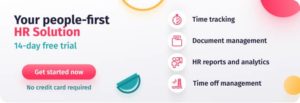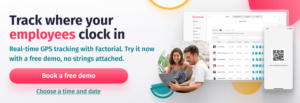According to the American Payroll Association, businesses in the United States lose billions of dollars every year due to time theft. This includes employees clocking in for each other, taking longer breaks than allowed, and “padding” their time cards. To overcome this issue, employers need to update their schedule tracking technology so that they have more insight into how employees are using their time. Using a tracking solution like a time card app to keep a log of employee hours doesn’t just protect you from time theft, either. It also helps you monitor performance and productivity levels and keeps you compliant with labor laws and regulations.
So, what is a time card app? And why is a digital solution more reliable than an analogue punch-in system? Which features should you look for in a time card app?
In today’s guide, we will share everything you need to know about time card apps, including benefits, common features, and things to keep in mind before you invest in a solution.
What is a time card app?
A time card app, also known as a time tracking app and a time clock app, is a software application used to track employee work hours. The app can be installed on a smartphone, tablet, or computer and can then be used to record clock-ins and clock-outs, breaks, and other work-related activities.
Time card apps can also help employers track employee attendance and manage payroll more efficiently. Plus, employees can keep track of their own working hours, view their schedules, and request time off when needed. More comprehensive solutions also include features such as GPS tracking, task management, and project tracking. This can be particularly useful for businesses with remote workers or those who work on multiple projects simultaneously.
Ultimately, time card apps can help simplify and streamline the process of tracking work hours, reduce errors and disputes, and improve overall productivity and efficiency.
Time card app features
Let’s take a look at some of these time card app features in a bit more detail to help you understand what to look out for before you invest in a solution.
Time clock
A time clock is a standard feature of all time card apps. It enables employees to clock in and out electronically, often via their smartphones or other mobile devices. Think of it as a traditional paper-based timesheet or analogue punch clock. Except instead, it is a digital app that employees can access from anywhere. This is a huge plus if you hire remote workers.
Most time clock features also include tools for tracking breaks, calculating hours worked, and applying overtime rules. Some even include high-tech features like facial recognition and geolocation tracking to confirm an employee’s identity and location.
All this helps you simplify the time-tracking process for both you and your employees.
Shift scheduling
The shift scheduling feature of a time card app allows managers to create and manage employee schedules, often through an online or mobile interface. Employees can view their schedules in advance, request time off, and receive notifications of any changes. The scheduling feature can also help managers ensure that they have the right number of employees scheduled for each shift, preventing scheduling conflicts and unnecessary overtime costs. Some shift scheduling features include templates, forecasting tools, and real-time updates to make it easier for managers to create and manage employee schedules.
Overtime tracking
The overtime tracking feature of a time card app helps businesses ensure compliance with labor laws and company policies relating to overtime pay. This feature automatically calculates overtime hours based on pre-set rules. For example, this might be when an employee works over a certain number of hours in a day or week. Managers can review and approve overtime requests, and they can also monitor employee overtime hours to prevent excessive overtime costs. This feature can also help businesses accurately track employee hours and pay, reducing errors and disputes related to overtime pay.
Leave management
Another common feature seen in many time card apps is leave management. An online leave management system helps you manage employee time off requests and accruals. Employees can request time off through the app, and managers can approve or deny requests, while also tracking employee leave balances. Many solutions can handle a variety of leave types, such as sick time, vacation time, and personal time. Some even include features for managing extended leaves of absence, such as family and medical leave.
Timesheet management
The timesheet management feature of a time card app allows employees to enter their hours worked, edit their time timesheets, and submit them for approval. It can also be used to track project or task hours, ensuring that time is accurately recorded for billing or project management purposes. Managers can review and approve timesheets, while also being able to monitor employee hours and spot errors or discrepancies.
Using a timesheet software solution like this can save you valuable time and help you maintain a more accurate record of employee hours worked.
Geolocation
Geolocation features use GPS or other location-based technology to track employee locations when they clock in or out of work. This can be especially useful for remote employee time tracking or if your staff work at multiple job sites. You can easily keep track of where your employees are located. That way, you can be sure that they are at the right location when clocking in or out.
The biggest benefit of this feature is that it can protect your business from time theft and other types of employee fraud.
Reporting and analytics
When you look for a time card app, it’s important to make sure you pick a solution with robust reporting capabilities. The right solution can provide you with detailed reports on employee attendance, hours worked, overtime, PTO, and other key metrics. Some apps even let you customize your reports to the specific needs of your business.
The best apps also include analytics features that can help you identify trends and patterns in employee attendance and performance. You can then use this data to optimize productivity and improve workforce management. Plus, maintaining accurate records in this way is essential for compliance with labor laws related to working hours and overtime.
Integration with payroll software
The final standard feature that you should look for when you compare time card apps is payroll software integration. This feature enables you to seamlessly transfer employee time and attendance data to your payroll system. This eliminates the need for manual data entry and reduces errors and inconsistencies that can occur during the payroll process.
Payroll software integration features often also include the ability to automatically apply pay rules and deductions to employee paychecks and generate detailed payroll reports. This can save you a lot of time and money. More importantly, it can greatly improve the accuracy and consistency of your payroll processing system.
Benefits of using time card apps
It’s good to know the basics of time-tracking apps, but it’s equally important to understand why your small business needs this tool.
Here are some of the specific benefits of using a time card app.
Improved accuracy
Time card apps can accurately track employee hours, eliminating errors and discrepancies that can occur with paper-based timesheets or manual tracking.
For example, employees can use the time clock to record the start and end times of each workday. A time card application can usually also track breaks so that you can be sure that employees are sticking to their assigned schedules. All this eliminates the need for manual timesheets and analogue clocks which are prone to errors and time-consuming. Instead, you get instant access to all the data you need to create accurate and timely payslips each month.
Increased efficiency
A time card app can help you create more efficient processes for tracking employee schedules, processing payroll, and time and expense tracking. This is because you can use the app to automate many of your processes, saving you a significant amount of time that you would otherwise spend on basic administration. You can then focus instead on more strategic tasks such as optimizing your employee experience, improving customer service, or developing new strategies to enhance performance.
Greater transparency
One of the biggest benefits of using an app for time cards is that employees have easy access to their hours worked, leave balances, and payslips. Not only does this enable them to better manage their schedules, but it also increases data transparency and reduces the likelihood of disputes related to pay. This transparency can help improve employee satisfaction and trust, which can result in increased productivity and reduced turnover.
Ensure compliance
As we already mentioned, time card apps help you maintain accurate records of hours worked. This not only improves the accuracy of your payroll system, but it also helps you stay compliant with labor laws and regulations related to time tracking, overtime pay, and paid time off. That way, you can maintain detailed reports and audit trails, and avoid costly fines and penalties.
Boost productivity
Finally, a time card app can help you optimize workforce management and improve employee scheduling.
How?
Because managers get access to real-time information on employee hours worked. This can help them make informed decisions related to scheduling and staffing. For example, they might use the data to identify potential overstaffing or understaffing issues. They can then implement measures to address these issues and optimize staffing levels. That way, your organization will always have the right number of employees working at the right times, increasing efficiency and productivity.
Best time card apps
Using a time card app is very simple. Your employees simply need to download the app on their devices then use it to log their working hours. You and your managers can then access all this data straight from the software and keep a close eye on hours worked and productivity.
However, different solutions offer different features so it’s important to conduct thorough research before investing in a solution. This includes reviewing the features offered by various time card apps, checking out pricing structures, and comparing the pros and cons of each solution. Some time card apps, for instance, focus more on employee accountability. Others are more geared towards scheduling and managing employee timesheets.
Here are a few time card app examples to get you started.
Factorial’s time card app
Factorial’s comprehensive HR software solution includes a robust time card app that you can use to streamline and enhance your time tracking and payroll processes and improve productivity. The time card app offers a range of features, including employee clock-in and clock-out tracking, shift scheduling, overtime tracking, leave management, timesheet management, geolocation tracking, reporting and analytics, and integration with payroll software.
One of the key benefits of Factorial’s time card app is its user-friendly interface. The app is intuitive and easy to use, allowing employees to quickly and easily clock in and out of work using their mobile devices or desktop computers. Best of all, they can access the employee clock-in system from any location, which is great if you hire remote workers. Plus, managers can view employee time cards in real-time, enabling them to make informed decisions related to scheduling and staffing.
Another benefit of Factorial’s time card app is its powerful reporting and analytics capabilities. The software provides detailed reports on employee hours worked, overtime, and leave balances. You can then use this data to make data-driven decisions related to workforce management and payroll processing.
Factorial’s time card app is offered as part of its HRIS. If you’re still not convinced, we offer a 14-day free trial for new users. You can find out more about Factorial’s pricing plans here.
Sling’s time card app
Sling’s time card app is designed to simplify time tracking and improve payroll processing. The app aims to make it easier for businesses to manage their workforce and streamline their operations. The time card app offers a range of features, including clock-in and clock-out tracking, shift scheduling, overtime tracking, leave management, timesheet management, and reporting and analytics.
Pricing:
Sling’s time card app is included in the Sling suite of tools and has different pricing plans. The Starter Plan is free, the Standard Plan costs $1.25/user/month (billed annually), and the Premium Plan is customized. Sling also offers a 14-day free trial and add-on features at an additional cost.
Pros:
- Intuitive interface
- Comprehensive feature set
- Affordable pricing plans.
Cons:
- Occasional glitches
- Limited customization options
- Some users have reported that it’s sometimes difficult to get technical support
Boomr’s time card app
Boomr’s time card app is a cloud-based time and attendance tracking solution for small and mid-sized businesses. It offers a range of features, including a time clock, GPS tracking, job and project tracking, leave management, reporting and analytics, integration with payroll software, automatic overtime calculations, and customizable settings. The app is available on desktop and mobile devices.
Pricing:
Boomr’s time card app offers three pricing plans: Basic, Standard, and Premium.
The Basic plan is free for up to 5 employees. The Standard plan costs $4.50/user/month, and the Premium plan is $8/user/month.
Pros:
- User-friendly interface
- Advanced GPS and geofencing features
- Easy integration with payroll software
- Mobile app available for both Android and iOS devices
Cons:
- While Boomr does offer messaging and communication features, it doesn’t include any organizational or scheduling tools
- Limited customization options
- Occasional glitches reported by some users
- Customer support can be slow to respond
Choosing the right time card app for your team
Choosing the right time card application is crucial for any business that wants to streamline its time tracking processes. When you evaluate different time card apps, make sure you look out for features such as time clocks, shift scheduling, leave management, overtime tracking, reporting and analytics, geolocation, and integration with payroll software.
Factorial’s time card app, included in our comprehensive people management software solution, offers all these features and more at an affordable price. For example, employees can use the time clock to clock in and out easily. And managers can use shift scheduling to plan and allocate resources efficiently. You also get access to a range of leave management tools so you can process time-off requests smoothly and efficiently. Plus, our overtime tracking tools help you stay compliant with labor laws and regulations.
Best of all, you can use Factorial’s reporting and analytics features to generate customized reports on all the above. You can then use these reports to gain valuable insights into your team’s performance. The app also integrates easily with payroll, saving you time and reducing errors in the payroll process.
Ultimately, our time card app offers an all-in-one solution for businesses of any size. The app’s intuitive interface, comprehensive feature set, and affordable pricing make it the best choice for any team looking to optimize its time and attendance tracking processes.




